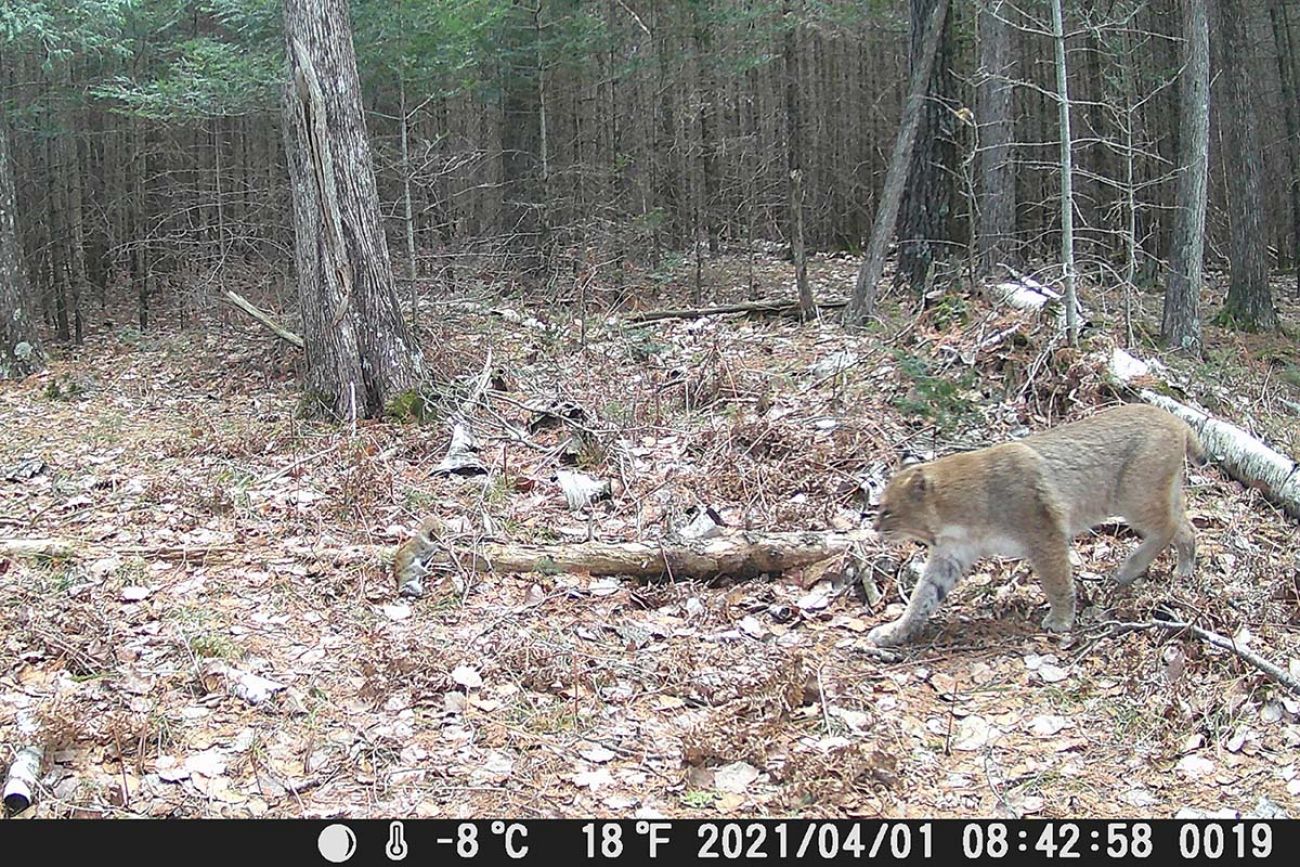Michigan moves to expand bobcat hunting as other states eye restrictions

Bobcat sightings are increasing in the southern Lower Peninsula, and state officials say their populations are now stable enough to expand hunting and trapping to that area.
The wild cats with bobbed tails, which are about twice the size of house cats, disappeared from the Lower Peninsula after the logging boom in the late 1880s. Now, as forestlands have slowly returned, the bobcats have bounced back as well.
“We’ve documented bobcats in every county in Michigan,” said Adam Bump, the bear and furbearer specialist for the Michigan Department of Natural Resources. “Over the last decade, we have seen an increase in people reporting sightings of bobcats in the Lower Peninsula. That’s very suggestive of a healthy, resilient population.”
Related:
- Michigan DNR camping reservations up 8 percent. Book now for busy sites.
- As Michigan DNR camping reservations soar, parks want COVID funds soon
The proposal comes as some states, including Illinois and Colorado, have considered legislation to ban hunting and trapping bobcats. California prohibited hunts outright in 2019, and Iowa last year dropped plans to expand hunting due to resident opposition.
Native to wooded areas throughout the United States, bobcats were endangered in some Midwestern states until the past 15 years. But changes in farming practices and a return of wooded areas led U.S. Fish and Wildlife Services researchers in 2010 to conclude that “populations are much higher than previously suggested.”
Opposition to hunts is fueled because the cats are hunted for their pelts and mostly stick to themselves, eating squirrels and avoiding humans.
Proponents counter that they’re so hard to hunt and trap, any expansion won’t hurt their population. Bobcats are stealthy, nocturnal and notoriously elusive: One Michigan survey found that only 365 of 2,810 people who hunted bobcats in northern Michigan bagged one.
Bump said the DNR has not gotten pushback but the agency only surveyed trappers.
“There are some (people) that just, in general, are not supportive or are wary of increases and harvest of any species,” Bump said.
DNR’s proposed bobcat hunting and trapping changes
The Michigan Natural Resources Commission meets at 9 a.m. Feb. 10 to consider changes to the bobcat season in Michigan. The meeting is at the Lansing Community College West Campus Room 119.
Proposed changes include:
- An 11-day hunting season from Dec. 10 to Dec. 20 and a trapping season from Jan. 1, 2023, to Jan. 11, 2023, with a one-bobcat per season bag limit, in the following southern Lower Peninsula counties: Muskegon, Montcalm, Gratiot, Saginaw, Ottawa, Kent, Ionia, Clinton and Shiawassee.
- The northern Lower Peninsula would have a trapping season from Dec. 10 to Dec. 29 and a hunting season from Jan. 1, 2023, to Jan. 20, 2023. The bag limit would be one per season.
- The Upper Peninsula would have a trapping season from Dec. 1 to Feb. 1, 2023, and a hunting season from Jan.y 1, 2023, to March 1, 2023. The bag limit is one per season unless the hunter or trapper receives a second license to catch another bobcat on private property.
The Department of Natural Resources proposes expanding the current 11-day hunting and trapping season in the northern Lower Peninsula to 20 days with two full weekends — and creating an 11-day season in the nine southern counties: Muskegon, Montcalm, Gratiot, Saginaw, Ottawa, Kent, Ionia, Clinton and Shiawassee.
The limit would be one bobcat per hunter or trapper in the Lower Peninsula. Hunters and trappers can kill two bobcats in the Upper Peninsula so long as one is caught on private property.
“With a new expansion, we try to be very conservative with season length and harvest until we look at the impacts of the season in that area,” Bump said.
The Natural Resources Commission, the agency that considers regulations for the DNR, will consider the proposal and take public comment at its Feb. 10 meeting in Lansing.
Nick Green, spokesperson for the Michigan United Conservation Clubs, said the group supports the expansion because it wouldn’t significantly reduce populations.
“Bobcats are a species that are hunted for very short seasons, and they’re predators which makes them hard to hunt,” Green said. “So, any kind of opportunity we can give (hunters and trappers) is great.”
The proposal comes as bobcat hunting has slowly been reintroduced in Michigan. Low populations made trapping bobcats illegal in the southern Lower Peninsula until the mid 2000s.
Bump said bobcats are coming back as they wander south from the north and reproduce. In the process, though, populations in the Upper Peninsula are lower than they were 20 years ago.
While Michigan doesn’t conduct population estimation surveys, nearby Wisconsin estimates there were about 3,800 bobcats in that state in 2019.
The Natural Resources Commission in 2018 listened to hunters, trappers, and the DNR before passing a resolution that kept bobcat season short in the Upper Peninsula while allowing people to get a second kill tag so long as the animal is killed on private property.
The DNR said it has no reason to believe the bobcat population in the Lower Peninsula will decline under the proposed regulations. Bump said that’s because the chances of killing a bobcat are still relatively low.
Bobcat hunting increased 17 percent from 2018 to 2020, as some 13,400 people registered to hunt or trap a bobcat. Less than half of the 1,887 trappers caught a bobcat, 621.
Ron Urkuski, who lives near the Au Sable River in Luzerne near Grayling, said he loves seeing more bobcats. Urkuski has hundreds of photos and videos of bobcats caught on a trail camera in his front yard. Over the years, Urkuski has even spotted bobcats in person.
“They’re really pretty,” Urkuski said. “I don’t mind people hunting them. I wouldn’t hunt them, even if I could. But the DNR is pretty good at knowing what the population is and there are a lot of bobcats here.”
Urkuski said the bobcats don’t bother him or damage his property. The state receives a very low number of nuisance complaints regarding bobcats.
Bobcat sightings may cause initial concern among people who are not used to seeing the animal because of its size, Bump said.
“But then they mostly think it’s cool that they saw one,” Bump said. “The number of complaints, like a bobcat eating someone’s chicken, are extremely low. Bobcats generally keep to themselves.”
Michigan Environment Watch
Michigan Environment Watch examines how public policy, industry, and other factors interact with the state’s trove of natural resources.
- See full coverage
- Subscribe
- Share tips and questions with Bridge environment reporter Kelly House
Michigan Environment Watch is made possible by generous financial support from:
Our generous Environment Watch underwriters encourage Bridge Michigan readers to also support civic journalism by becoming Bridge members. Please consider joining today.
See what new members are saying about why they donated to Bridge Michigan:
- “In order for this information to be accurate and unbiased it must be underwritten by its readers, not by special interests.” - Larry S.
- “Not many other media sources report on the topics Bridge does.” - Susan B.
- “Your journalism is outstanding and rare these days.” - Mark S.
If you want to ensure the future of nonpartisan, nonprofit Michigan journalism, please become a member today. You, too, will be asked why you donated and maybe we'll feature your quote next time!






